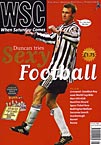 Matthew Hall salutes Peter Wilson, the only World Cup captain to frequent a bar in Wollongong
Matthew Hall salutes Peter Wilson, the only World Cup captain to frequent a bar in Wollongong
The barman at Kembla Heights Bowling Club, a breezy two-hour drive south from Sydney, probably would not be able to enlighten you too much about the local football scene. But the chances are he’s pulled a few beers for Peter Wilson, Australia’s most enigmatic and mysterious sporting legend. And that makes this place a classy joint.
“Big Willie” pitched up in Wollongong in 1968, aged 21, having spent four unproductive years at Middlesbrough. Built like a Viking, he cut an imposing figure at South Coast United and it wasn’t just his silk shirts and flared trousers that got him noticed. He played as a sweeper, was calm in times of trouble and, despite being a quiet bloke off the pitch, was a deft organiser on it.
He soon came to the attention of Rale Rasic, then national coach. Rasic was never orthodox in his manner or views. Prior to a 1973 World Cup qualifier in Tehran he told the Iranian media that Australia would triumph over the home team simply because they were “the superior race” (T Venables take note). Rasic’s choice of Wilson to lead the team was surprising, but inspired. Wilson introduced the music of Tim Buckley and Van Morrison to the dressing room (touché, so-called “Crazy Gang”), wasn’t much of a drinker (but once quaffed 16 pints to find out what the fuss was about) and led Australia to the 1974 World Cup finals.
Compared with the sophisticated European and South American professionals the Socceroos were a virtual novelty act in West Germany. It wasn’t just the curious multicultural melange of European migrants and home-grown talent, which included Harry Williams, the one and only Aboriginal Australian to grace a World Cup. Bona fide part-timers, the majority of the squad took holidays from work to make the tournament. Their plastic flip-flops, dangerously tight shorts and marsupial mascots also endeared them ⌦to the German public, yet the Socceroos were far ⌦from disgraced on ⌦the pitch.
They frustrated eventual champions West Germany enough for the home crowd to boo their own team and start chanting for Australia. At the final whistle, despite having won 3-0, Franz Beckenbauer stormed off the pitch, refusing to swap shirts with the Australian skipper. Peter Wilson claimed the moral victory as one of his greatest games.
Wilson and the Socceroos should have returned home to gilt and glitter but the game’s administrators once more failed to seize a moment to push soccer into the forefront of a hungry public. It wasn’t until last year’s infamous Melbourne showdown with Iran that the 1974 team was publicly honoured. It was even left to a former player to organise the first-ever squad reunion just two months before that.
By 1982, Wilson had forgone his Viking image, replacing it with a voluminous moustache, and resembled a giant walrus. It was also the year he played his last-ever competitive game, a Cup final in front of just 5,000 people at Melbourne’s Olympic Park. Then player-manager of Sydney’s APIA-Leichhardt, blood poured from a cut above his right eye as he led APIA to a 2-1 win over Melbourne’s Heidelberg. When the final whistle blew Wilson walked right out of the stadium and never spoke of football again.
Willie returned to Wollongong and his job as a coalminer. He skipped through the loop that circles former players, the media and the hangers-on. He grew his hair to his hips, added a beard to match, became a vegetarian and switched his interests to vintage Harley-Davidson motorbikes. Planet football? Wilson fell right off it.
Over the years, journalists have occasionally tried to obtain a quote, a story, even an explanation. None succeeded. All requests were, and still are, met with awkward silence. An Australian fan from Hanover in Germany is the only person known to have had any success. A brief exchange of letters ensued before Wilson sent a gift. It was the torn-off national crest from one of Wilson’s spare Socceroo shirts – the one he wore against West Germany in 1974. “I hope you can find some use for it,” Wilson wrote. In exchange, he requested some European motorbike magazines.
So, the only chance to brush shoulders with a true colossus of the Australian game is at Willie’s local watering hole – the Kembla Heights Bowling Club. With its views over the Pacific and its slow, sunny pace it’s the perfect place to idle away an afternoon and shoot the breeze with the locals. Just don’t ask the tall bloke in the corner with the beard around his ankles to spin another one of those World Cup yarns. Not that he’d answer, anyway.
From WSC 143 January 1999. What was happening this month